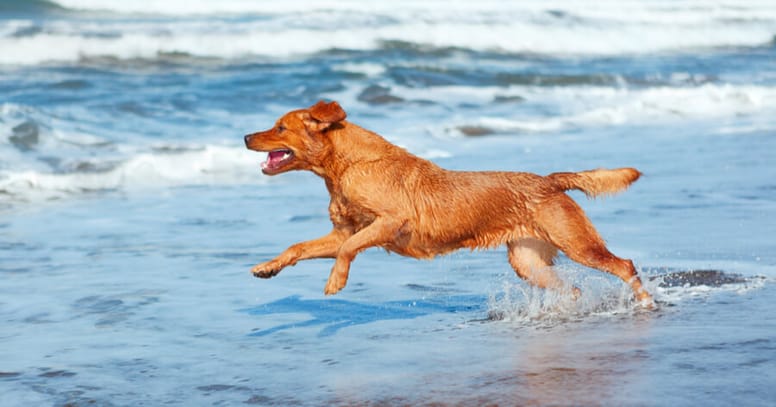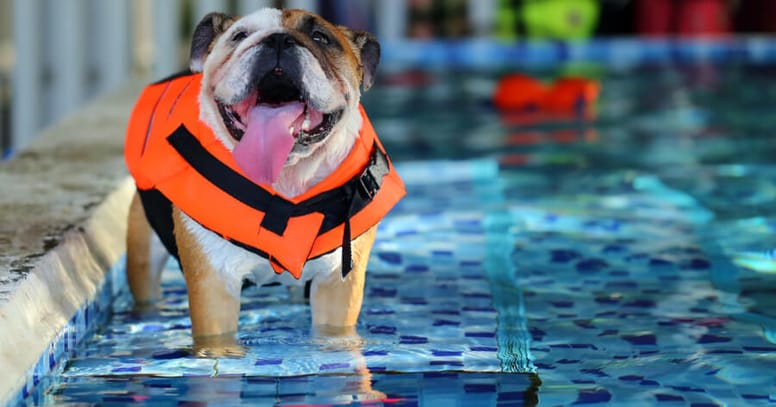Not every dog is born to swim. Although they have an instinctive swimming style, they are not as good at staying afloat as we may think. Our selective breeding of generations of dogs for a variety of purposes has led to some being too heavy, too short or too weak to support their own weight in the water. For many of our breeds of dog, paddling will no longer save them.
Nevertheless training your dog to swim is still a useful exercise. If done correctly, a dog that has learned to swim will be less scared of water and able to cope with getting wet.
Can all breeds of dogs swim?
Not all dogs can swim. True, dogs used to feel very comfortable in the water, and some still do. Wolves are exceptionally adept swimmers and they will not hesitate to wade through water that is still, running, warm or icy cold. But since dogs were first brought in from the wild we have bred, interbred, crossbred and selectively bred them to perform various tasks and to be expert on one or two tasks.
Of the 344 breeds now recognised by the Fédération Cynologique Internationale few of them are swimmers, and some are positively dreadful ones. Due to their size, skeletal form or fur some breeds of dog are more likely to sink before they even have a chance to paddle (we will have a look at specific breeds in a moment).
And that poses a problem for owners, especially owners who live near water. Here in the UK, there are almost 8,000 miles of coastline, and hundreds of villages, towns and cities spread along its length; inland there are countless lakes and rivers.
Is a dog a natural swimmer?
The ancestors of dogs would have had a good natural ability to swim. However, our selective breeding of dogs has caused some dogs to be better swimmers than others. Dogs that we have bred to retrieve waterfowl are, unsurprisingly, exceptional swimmers.
So too dogs that were bred to assist fishermen in their work are also comfortable in the water. They have a physique (artificially bred) that is well balanced, buoyant and will withstand the cold. These dogs can wade confidently through water and, furthermore, actually enjoy the sense of swimming.

Which dog has the best swimming ability?
Of all the 344 breeds of dog there are several that stand out as good swimmers. These are dogs that, as we mentioned, have been bred for a waterborne purpose: either to help fishermen or hunters. Our top five swimmers are:
Which dog breeds are not swimmers, and why?
Generally speaking breeds of dog with the following characteristics will be considered poor swimmers, and at risk when walking near water:
- Heavy dogs with large, muscular heads
- Brachycephalic (squashed-nose) dogs
- Dogs with stumpy legs, legs shorter proportionately
No matter how hard these dogs try to swim they will not be able to stay afloat. Their bone structure and appearance hinder their chances of survival in the water. More often than not it is the dog bred as a companion or for specialist duties in the human world that is now unable to tap into its lupine swimming skills.
The following breeds are thought to be the worst swimmers, hindered by their anatomy and facial appearance (flat, short muzzle or disproportionately large skull):
The squashed-nose breeds such as the bulldog and pug must struggle in the water to keep their head above the surface; it will spend a lot of energy doing this and will tire easily. A retriever on the other hand can swim vertically in the water: more efficient and safer. Some dogs adept at swimming may even swim underwater.
Dogs such as the Dachshund have not the strength or wading ability of their legs to support their buoyancy; in other words, it is likely that a Dachshund would sink if placed in reasonably deep water (although clearly it would be foolish to test that theory). A dog with a skull larger than it should be, such as the Mastiff, would similarly struggle to keep its head above the water.
How to teach my dog to swim?
If your dog is not a good swimmer or belongs to a breed that has not the physical attributes of a swimmer, you should be careful when near water. If necessary invest in a life jacket for your dog especially if you intend to travel over the water or your vet suggests the dog should undergo hydrotherapy.
If you want to try to teach your dog to swim (regardless of his breed) you should at the very least first check whether your dog is capable of supporting its own weight on the water. You may do this by carefully lowering him onto water that is not deep, nor running, nor too cold.
To train your dog to swim, follow these next steps:
- Allow your dog to approach the water in his own time. Never force the dog to swim; doing so will cause him to be scared of the water.
- If you believe your dog is not the best swimmer in the world always make sure he wears his life jacket when swimming.
- Encourage your dog to follow you into water that is shallow enough for him to stand up in. Reward him when he does so.
- Gradually tempt your dog into deeper water, until he is swimming beside you. When you sense the dog is comfortable with his swimming style you can encourage him to swim a little distance towards you.

Why do dogs try to ‘swim’ when held in the air?
Despite what some people opine, the doggy air paddle is not the dog’s way of preparing itself to swim. Although wolves and some dogs are good swimmers, water is not the natural habitat of a dog so it is unlikely that a dog’s natural instinct is to paddle as if it was in the water.
The air paddle is more likely to be a response to being picked up. Dogs do not expect to be picked up, and will react with a frantic movement of their limbs to so being. The air paddle may be linked to a mammalian startle reflex but it is more likely to be a simple panic movement associated with an unexpected movement.
What to look out for when teaching a dog to swim?
Always try to be patient when teaching your dog to swim. A dog that is not used to water should be trained in a supportive and non-time-critical situation. Dogs – even big dogs - can easily become overwhelmed by new experiences, and their doing so could be the difference between success and failure of the training.
A worthwhile exercise is to train a dog to swim when it is still young. Puppies are much easier to handle, are more inquisitive and do not approach tasks with the preconceptions of adult dogs. Love your dog through the process and you will be able to train your dog to swim, but: make sure he always wears a life jacket.

